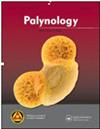青藏高原东南缘现代花粉的垂直分布
IF 1.3
4区 地球科学
Q3 PALEONTOLOGY
引用次数: 0
摘要
摘要青藏高原东南部热带山区因其丰富的生物多样性而成为生态环境研究的热点。然而,由于对该地区现代花粉雨的认识有限,阻碍了利用花粉记录对生态环境演化进行进一步调查研究。在青藏高原东南部墨脱县,从热带低地到亚高山(海拔740 ~ 3550 m)采集了62份现代花粉样本,并进行了花粉分析。采用聚类分析、冗余分析、方差划分分析、增强回归树等方法研究了花粉与植被气候的关系。此外,利用山数(N0、N1、N2)和特异性占用样地来研究植物多样性。结果表明,墨脱现代花粉雨能较好地反映植被的当前特征,包括原生特征和次生特征。青冈、银杉和冷杉花粉是2100 m海拔以上原始植被的主要组成部分,可以作为古植被重建的指示种。年平均降水量是影响花粉分布最重要的气候决定因素。花粉多样性指数显示,研究区植物多样性随海拔呈“相对高-低-高-低”的双峰型格局。2100 m海拔高度以上的植物多样性主要由原生植被决定,2100 m海拔高度以下的植物多样性则由中间干扰假说解释。此外,在开阔的山地环境中,由于山谷风增加了潜在的花粉源面积,在处理树木花粉均匀性时应谨慎行事。关键词:现代花粉雨植被-花粉关系-花粉气候关系-花粉多样性海拔梯度青藏高原东南部免责声明为服务作者和研究人员,我们提供此版本的接受稿件(AM)。在最终出版版本记录(VoR)之前,将对该手稿进行编辑、排版和审查。在制作和印前,可能会发现可能影响内容的错误,所有适用于期刊的法律免责声明也与这些版本有关。利益声明作者声明,他们没有已知的竞争经济利益或个人关系,可能会影响本文所报道的工作。作者感谢赵文茜和李明佳在野外工作中的帮助。我们也感谢两位匿名审稿人,他们给了我们重要的建议,让我们提高了稿件的质量。国家重点研发计划项目(2022YFF0801101)和国家自然科学基金项目(批准号42077424,42277446)资助。本文章由计算机程序翻译,如有差异,请以英文原文为准。
The vertical distribution of modern pollen in the southeastern edge of Tibetan Plateau, China
AbstractThe tropical mountainous area of the southeastern Tibetan Plateau (TP) is a hotspot of ecological environment research because of its rich biodiversity. However, limited knowledge regarding modern pollen rain within this area has impeded further investigation research on eco-environmental evolution by using pollen record. Here, we collected 62 modern pollen samples from lowland tropics to the subalpine (740-3550 m a.s.l.) in Medog County, located in the southeastern TP, and performed pollen analysis. Cluster analysis, redundancy analysis, variance partitioning analysis, boosted regression trees were employed to investigate the relationship between pollen and vegetation-climate. Additionally, Hill numbers (N0, N1, N2) and specificity-occupancy plots were utilized to explore plant diversity. The results indicate that modern pollen rain in Medog can reflect well the current characteristics of vegetation, encompassing both primary and secondary features. Pollen of Cyclobalanopsis, Tsuga and Abies, which are dominant components of the primary vegetation above 2100 m a.s.l., can serve as indicator species for palaeovegetation reconstruction. Mean annual precipitation is the most important climatic determinant affecting pollen distribution. Pollen diversity indices reveal that the plant diversity in this study area has a bimodal pattern of “relatively high-low-highest-low” with altitude. The plant diversity above 2100 m a.s.l. is mainly decided by primary vegetation, whereas below 2100 m a.s.l. can be explained by the intermediate disturbance hypothesis. Furthermore, it is advisable to exercise caution when dealing with arboreal pollen evenness in open mountainous environments due to the increased potential pollen source area caused by valley wind.Keywords: Modern pollen rainvegetation-pollen relationshippollen-climate relationshippollen diversityaltitudinal gradientsoutheastern Tibetan PlateauDisclaimerAs a service to authors and researchers we are providing this version of an accepted manuscript (AM). Copyediting, typesetting, and review of the resulting proofs will be undertaken on this manuscript before final publication of the Version of Record (VoR). During production and pre-press, errors may be discovered which could affect the content, and all legal disclaimers that apply to the journal relate to these versions also. Declaration of InterestsThe authors declare that they have no known competing financial interests or personal relationships that could have appeared to influence the work reported in this paper.AcknowledgementsThe authors are grateful to Zhao Wenqian and Li Mingjia for help with fieldwork. We also thank two anonymous reviewers who gave us important advice that let us improve the manuscript’s quality. This work was supported by National Key Research and Development Program of China (2022YFF0801101) and National Natural Science Foundation of China (Grant No. 42077424, 42277446).
求助全文
通过发布文献求助,成功后即可免费获取论文全文。
去求助
来源期刊

Palynology
地学-古生物学
CiteScore
3.40
自引率
26.70%
发文量
48
审稿时长
>12 weeks
期刊介绍:
Palynology is an international journal, and covers all aspects of the science. We accept papers on both pre-Quaternary and Quaternary palynology and palaeobotany. Contributions on novel uses of palynology, review articles, book reviews, taxonomic studies and papers on methodology are all actively encouraged.
 求助内容:
求助内容: 应助结果提醒方式:
应助结果提醒方式:


